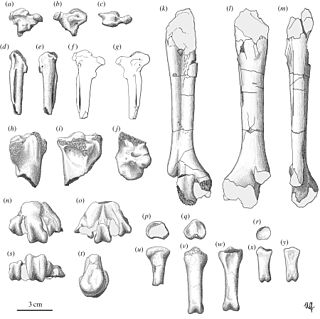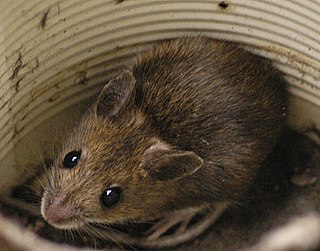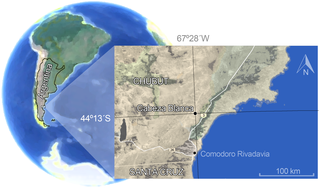
The Cricetidae are a family of rodents in the large and complex superfamily Muroidea. It includes true hamsters, voles, lemmings, muskrats, and New World rats and mice. At over 870 species, it is either the largest or second-largest family of mammals, and has members throughout the Americas, Europe and Asia.

Eutamias is a genus of chipmunks within the tribe Marmotini of the squirrel family. It includes a single living species, the Siberian chipmunk. The genus is often treated as a subgenus of Tamias, which is now restricted to the eastern chipmunk of North America. Neotamias, which now includes the western North American chipmunks, has also been included in Eutamias.

The Laotian rock rat or kha-nyou, sometimes called the "rat-squirrel", is a species of rodent found in the Khammouan region of Laos. The species was first described in a 2005 article by Paulina Jenkins and coauthors, who considered the animal to be so distinct from all living rodents, they placed it in a new family, Laonastidae. It is in the monotypic genus Laonastes.
Pseudoltinomys is a prehistoric rodent that lived approximately 30 million years ago, during the Oligocene epoch. It outwardly resembles a gerbil, but may have been related to kangaroo rats or may represent an early offshoot of rodents with no modern relatives.

Diatomyidae is a family of hystricomorph rodents. It is represented by a single living species, Laonastes aenigmamus, native to Laos in Southeast Asia. Fossil species are known from the Oligocene and Miocene of Asia and eastern Europe.

Cramauchenia is an extinct genus of litoptern South American ungulate. Cramauchenia was named by Florentino Ameghino. The name has no literal translation. Instead, it is an anagram of the name of a related genus Macrauchenia. This genus was initially discovered in the Sarmiento Formation in the Chubut Province, in Argentina, and later it was found in the Chichinales Formation in the Río Negro Province and the Cerro Bandera Formation in Neuquén, also in Argentina, in sediments assigned to the SALMA Colhuehuapian, as well as the Agua de la Piedra Formation in Mendoza, in sediments dated to the Deseadan. In 1981 Soria made C. insolita a junior synonym of C. normalis. A specimen of C. normalis was described in 2010 from Cabeza Blanca in the Sarmiento Formation, in sediments assigned to the Deseadan SALMA.

Eomyidae is a family of extinct rodents from North America and Eurasia related to modern day pocket gophers and kangaroo rats. They are known from the Middle Eocene to the Late Miocene in North America and from the Late Eocene to the Pleistocene in Eurasia. Eomyids were generally small, but occasionally large, and tended to be squirrel-like in form and habits. The family includes the earliest known gliding rodent, Eomys quercyi.

Rodents are mammals of the order Rodentia, which are characterized by a single pair of continuously growing incisors in each of the upper and lower jaws. About 40% of all mammal species are rodents. They are native to all major land masses except for Antarctica, and several oceanic islands, though they have subsequently been introduced to most of these land masses by human activity.

Ysengrinia is an extinct genus of carnivoran in the family Amphicyonidae, that lived during the Late Oligocene to Early Miocene. Fossil remains have been discovered in Western Europe, the United States and possibly China. The European species are among the earliest known members of the Thaumastocyoninae, a group of aberrant amphicyonids showcasing hypercarnivorous adations, but are only known from fragmentary remains. The American species is much better preserved and shows a robust, black-bear sized predator. These fossils play an important role in our understanding of the biotic interchange between Eurasia and North America during the earliest Miocene. However, more recent research suggests that the genus might be polyphyletic, and that several of its species should be excluded from Ysengrinia.
This paleomammalogy list records new fossil mammal taxa that were described during the year 2012, as well as notes other significant paleomammalogy discoveries and events which occurred during that year.
This paleomammalogy list records new fossil mammal taxa that were described during the year 2013, as well as notes other significant paleomammalogy discoveries and events which occurred during that year.
This paleomammalogy list records new fossil mammal taxa that were described during the year 2011, as well as notes other significant paleomammalogy discoveries and events which occurred during that year.
This paleomammalogy list records new fossil mammal taxa that were described during the year 2010, as well as notes other significant paleomammalogy discoveries and events which occurred during that year.
This paleomammalogy list records new fossil mammal taxa that were described during the year 2009, as well as notes other significant paleomammalogy discoveries and events which occurred during that year.

Garganornis is an extinct genus of enormous flightless anatid waterfowl from the Late Miocene of Gargano, Italy. The genus contains one species, G. ballmanni, named by Meijer in 2014. Its enormous size is thought to have been an adaptation to living in exposed, open areas with no terrestrial predators, and as a deterrent to the indigenous aerial predators like the eagle Garganoaetus and the giant barn owl Tyto gigantea.
This paleomammalogy list records new fossil mammal taxa that were described during the year 2016, as well as notes other significant paleomammalogy discoveries and events which occurred during that year.

The Cerro Azul Formation, also described as Epecuén Formation, is a geological formation of Late Miocene age in the Colorado Basin of the Buenos Aires and La Pampa Provinces in northeastern Argentina.

Apodemini is a tribe of muroid rodents in the subfamily Murinae. It contains two extant genera, one found throughout Eurasia and the other endemic to the Ryukyu Islands. Several fossil genera are also known from throughout Eurasia, including one large species (Rhagamys) that persisted on Sardinia and Corsica up until at least the first millennium BC, when it was likely wiped out by human activity.

The Sarmiento Formation, in older literature described as the Casamayor Formation, is a geological formation in Chubut Province, Argentina, in central Patagonia, which spans around 30 million years from the mid-Eocene to the early Miocene. It predominantly consists of pyroclastic deposits, which were deposited in a semi-arid environment. It is divided up into a number of members. The diverse fauna of the Sarmiento Formation, including a variety of birds, crocodilians, turtles and snakes, also includes many mammals such as South American native ungulates as well as armadillos, and caviomorph rodents.
Eoviscaccia is an extinct genus of chinchillid rodent that lived during the Early Oligocene (Tinguirirican) to the Early Miocene (Colhuehuapian) in what is now South America. Fossils of this genus have been found in the Cerro Bandera, Chichinales, Fray Bentos, and Sarmiento Formations of Argentina, the Salla Formation of Bolivia, and the Abanico Formation of Chile.










